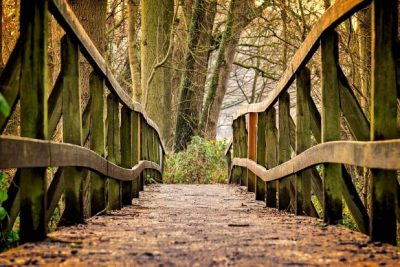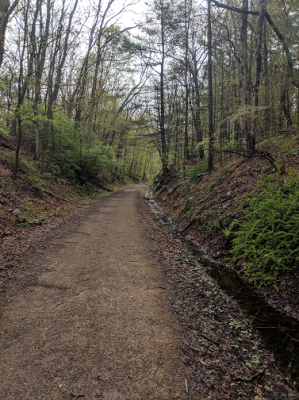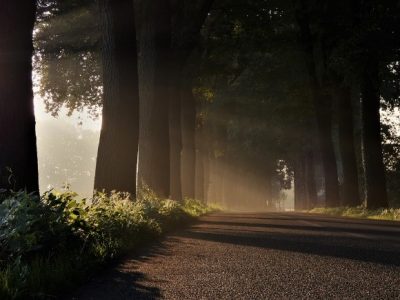Routes1,2
 It is better to propose several different trail routes, of different lengths or levels of challenge. The best trail systems include a variety of routes that allow rides of 2 to 3 hours, a half-day, and a full day or more. Tracks with loops allow users to explore more paths covering a smaller area.
It is better to propose several different trail routes, of different lengths or levels of challenge. The best trail systems include a variety of routes that allow rides of 2 to 3 hours, a half-day, and a full day or more. Tracks with loops allow users to explore more paths covering a smaller area.
Horse trails should usually be designed to cover a least 5 miles. It takes 1 to 2 hours for most equestrians to ride an average 5-mile trail.
Trails should provide reasonable access to water. According to the Forest Service, water must be provided at intervals of no more than 10 miles. If water is not available within this distance, riders should plan to circle back to their trailers. In areas with very hot weather, consider including water sources at 5 to 6 intervals.
Bridge design1,3

Bridges require a special designs fitted to each type of use. On national forests, all bridge designs must be approved by Engineering before being constructed. Some regions have standardized, approved designs for simple bridges.
For equestrian use, you need heavy-duty construction when it comes to bridges. Bridges must be designed to support every user, including service vehicles.
Bridges are expensive, so it makes sense to take good care of them. Check foot logs and bridges annually for problems. Loose decking, planking, curbs, or handrails should be repaired as soon as possible. Clean debris and organic material from all exposed wood surfaces on the bridge. The Forest Service requires all bridge structures to be inspected by a certified bridge inspector at least every 5 years.
Materials
 Materials
Materials
Choosing the materials for a bridge is not a simple process.
Often, materials are imported to avoid the problem of “clearcuts” near the bridge. Pressure-treated wood, metal, concrete, wood laminates, and even fiber-reinforced polymers are being used in bridges.
Width

Width2,4
No national standards establish the width of shared-use trails. Determining the best trail width is site-specific and depends on many factors, including safety, types of trail users and their needs.
Usually, horses and mules require a tread that's at least 1.5 to 2 feet wide. The trail animal and rider require about 4 feet of unobstructed width, and pack stock with loads require a minimum unobstructed width of 5 feet. If stock frequently carry bulky items, the suggested minimum clearing width is 6 feet.
Surfaces
Surfaces3

Trail surfaces could be hard (e.g. soil cement, granular stone, asphalt) or soft (e.g. natural earth, wood chips) according to the material’s ability to absorb or repel moisture.
Hard-surfaced materials are more practical for multi-use trails. It encourages more users to use it.
Softer surfaces are more comfortable if you are riding a horse but limits your speed. The softer the surface, the slower the speeds a horse can go.
Hard-packed soil
It will support most user groups; however, bicyclists and horseback riders will have the greatest impact on the surface.
It is inexpensive to install but you have to control vegetation and make sure the drainage is good.
Granular stone
It is very popular because if it is properly packed, it accommodates a wide variety of trail users.
For an ideal surface, spread the granular stone into a layer at least 4 inches thick over a prepared sub-grade and compact it with a motor grader. Maintenance is minimal.
Asphalt
It is usually popular on trail that are used for bicycle or in-line skating.
Equestrians generally cannot use an asphalt trail because it is hard on horses ‘hooves, and the hooves can leave imprints in hot weather. To avoid these limitations, a softer parallel tread may be constructed along an asphalt trail or wide enough shoulder for those who prefer a softer surface.

Natural surface
It requires less preparation than harder surfaces, but you will need to remove rocks, tree roots, and other obstructions from the subgrade. You will also need to fix drainage problem and eroded areas.
Wood chips
It is an attractive spongy surface. It works well as a parallel tread next to asphalt for example. However, this soil decomposes rapidly under prolonged exposure to sun, heat and humidity.
Soil types in Connecticut5
The ratings are based on the soil properties that affect trafficability and erodibility. These properties are stoniness, depth to a water table, ponding, flooding, slope and texture of the surface layer.
Not limited: soil types best suited for horseback riding
- Agawam fine sandy loam
- Ashfield fine sandy loam, not very stony
- Bice fine sandy loam, 3 to 15 percent slopes
- Bice-Millsite complex, 3 to 15 percent slopes
- Boscawen gravelly sandy loam, 0 to 15 percent slopes
- Gloucester gravelly sandy loam, 0 to 15 percent slopes
- Hinckley
- Manchester
- Manchester gravelly sandy loam, 0 to 15 percent slopes
- Merrimac sandy loam
- Ninigret fine sandy loam
- Ondawa fine sandy loam
- Pyrities loam, 0 to 25 percent slopes
- Schroon fine sandy loam
- Shelburne fine sandy loam
- Sudbury sandy loam
- Taconic, 0 to 15 percent slopes
- Westminster-Millsite-Rock outcrop complex, 3 to 15 percent slopes
Somewhat limited: soil types somewhat suited for horseback riding
| Soil name | Reason for somewhat suited |
| Agawam – urban land | Could be dusty |
| Agawam fine sandy loam, 0 to 8 percent slopes | Could be dusty |
| Agawam fine sandy loam, 8 to 15 percent slopes | Water erosion, Could be dusty |
| Ashfield, very stony | Large stones content |
| Bash silt loam | Depth to saturated zone, Flooding, Could be dusty |
| Belgrade silt loam | Could be dusty |
| Berlin silt loam | Could be dusty |
| Berlin-Urban land – urban land | Could be dusty |
| Bernardston silt loam, 3 to 8 percent slopes | Could be dusty, Could have large stones content |
| Bice fine sandy loam | Large stones content |
| Bice fine sandy loam, 15 to 25 percent slopes | Slope |
| Brancroft – urban land | Could be dusty |
| Brancroft silt loam | Could be dusty |
| Branford – urban land | Could be dusty |
| Branford silt loam, 0 to 8 percent slopes | Could be dusty |
| Branford silt loam, 8 to 15 percent slopes | Water erosion, Could be dusty |
| Broadbrook – urban land | Could be dusty |
| Broadbrook silt loam, 0 to 8 percent slopes | Could be dusty, Could have large stones content |
| Canton and Charlton fine sandy loams | Could be dusty, Could have slope, and large stone content |
| Charlton – urban land | Could be dusty |
| Charlton-Chatfield complex | Large stones content, Could dusty, Slope |
| Chatfield | Large stone content, Could be dusty, Slope |
| Chatfield – urban land, 0 to 15 percent slopes | Large stone content, Could be dusty |
| Cheshire – urban land | Could be dusty |
| Cheshire fine sandy loam | Could be dusty |
| Cheshire, 3 to 15 percent slopes | Large stone content, Could be dusty |
| Copake fine sandy loam | Could be dusty |
| Deerfield – urban land | Too sandy |
| Deerfield loamy fine sand | Could be too sandy |
| Dummerston, 3 to 15 percent slopes | Large stone content |
| Ellington silt loam | Could be dusty |
| Elmridge – urban land | Could be dusty |
| Elmridge fine sandy loam | Could be dusty |
| Enfield silt loam, 0 to 8 percent slopes | Could be dusty |
| Farmington-Nellis complex, 3 to 15 percent slopes | Could be dusty |
| Georgia – urban land | Large stones content |
| Georgia and Amenia silt loams, 2 to 8 percent slopes | Could be dusty |
| Gloucester gravelly sandy loam, 15 to 25 percent slopes | Slope |
| Gloucester gravelly sandy loam, 3 to 15 percent slopes, very stony | Large stone content |
| Groton gravelly sandy loam, 0 to 15 percent slopes | Could be dusty |
| Hadley silt loam | Could be dusty |
| Hartford sandy loam | Could be dusty |
| Haven – urban land | Could be dusty |
| Haven silt loam, 3 to 8 percent slopes | Could be dusty |
| Hero gravelly loam | Could be dusty |
| Hinckley loamy sand, 0 to 15 percent slopes | Too sandy |
| Hogansburg | Depth to saturated zone, Large stone content, Could be dusty |
| Hollis, 0 to 15 percent slopes | Large stone content, Could be dusty |
| Lanesboro loam, 3 to 15 percent slopes | Large stones content |
| Ludlow – urban land | Could be dusty |
| Ludlow silt loam, 0 to 8 percent slopes | Could be dusty |
| Ludlow silt loam, 2 to 8 percent slopes, very stony | Large stone content, Could be dusty |
| Macomber | Slope |
| Merrimac – urban land | Could be dusty |
| Merrimac fine sandy loam | Could be dusty |
| Narragansett – urban land | Could be dusty |
| Narragansett silt loam, 2 to 8 percent slopes | Could be dusty, Could have large stones content |
| Nellis fine sandy | Could be dusty, Could have large stones content |
| Ninigret – urban land | Could be dusty |
| Ninigret fine sandy loam | Could be dusty |
| Occum fine sandy loam | Could be dusty |
| Paxton – urban land | Could be dusty |
| Paxton and Montauk fine sandy loams | Could be dusty, Slope from 15 percent |
| Penwood – urban land | Too sandy |
| Penwood loamy sand | Could be too sandy |
| Pootatuck fine sandy loam | Flooding, Could be dusty |
| Pyrities loam, 0 to 25 percent slopes, very stony | Large stone content |
| Rainbow – urban land | Could be dusty |
| Rainbow silt loam, 2 to 8 percent slopes, very stony | Large stone content, Could be dusty |
| Rainbow silt loam, 3 to 8 percent slopes | Could be dusty |
| Stockbridge – urban land | Could be dusty |
| Stockbridge loam, 0 to 15 percent slopes | Could be dusty, Could have large stone content |
| Sudbury sandy loam | Could be dusty |
| Suncook loamy fine sand | Too sandy |
| Sutton – urban land | Depth to saturated zone, Could be dusty |
| Sutton fine sandy loam | Depth to saturated zone, Could be dusty, Could have large stones content |
| Taconic, 15 to 25 percent slopes | Slope |
| Tisbury silt loam | Could be dusty |
| Udifluvents | Flooding, Could be dusty |
| Udorthents – urban land | Slope, Could be dusty |
| Verrazano urban land complex | Could be dusty |
| Wapping – urban land | Depth to saturated zone, Could be dusty |
| Wapping very fine sandy loam | Could be dusty |
| Watchaug – urban land | Could be dusty |
| Watchaug fine sandy loam | Could be dusty |
| Wethersfield – urban land, 3 to 8 percent slopes | Could be dusty |
| Wethersfield loam, 3 to 8 percent slopes | Could be dusty, Could have large stones content |
| Windsor – urban land | Too sandy |
| Windsor loamy sand | Could be too sandy |
| Winooski silt loam | Flooding, Could be dusty |
| Woodbridge – urban land | Depth to saturated zone, Could be dusty |
| Woodbridge fine | Depth to saturated zone, Could be dusty |
| Woodbridge fine sandy loam, very stony | Large stones content, Depth to saturated zone, Could be dusty |
| Yalesville – urban land | Could be dusty |
| Yalesville fine sandy loam | Could be dusty |
Very limited: soil types not suited for horseback riding
| Soil name | Reason for unsuitability |
| Bernardston silt loam, 8 to 15 percent slopes | Water erosion, Could be dusty |
| Bice-Millsite complex, 3 to 15 percent slopes | Slope |
| Boscawen gravelly sandy loam, 15 to 45 percent slopes | Slope |
| Brandford Holyoke complex | Water erosion, Could be dusty, Could have stones content |
| Brayton loam | Depth to saturated zone, Could have large stone content |
| Brayton mucky silt loam | Depth to saturated zone, Large stone content |
| Brimfield | Large stone content, Slope, Could be dusty |
| Broadbrook silt loam, 8 to 25 percent slopes | Water erosion, Slope, Could have large stone content, Could be dusty |
| Bucksport muck | Depth to saturated zone, Organic matter content, Ponding, Could be dusty |
| Canton and Charlton fine sandy loams | Large stones content, Could be dusty |
| Chatfield – urban land, 15 to 25 percent slopes | Slope, Large stone content, Could be dusty |
| Cheshire fine sandy loam, 3 to 35 percent slopes, extremely stony | Large stone content, Slope, Could be dusty |
| Cheshire, 15 to 35 percent slopes | Slope, Large stone content, Could be dusty |
| Dummerston, 15 to 45 percent slopes | Slope, Large stone content |
| Enfield silt loam, 8 to 15 percent slopes | Water erosion, Could be dusty |
| Farmington-Nellis complex, 15 to 35 percent slopes | Slope, Large stone content, Could be dusty |
| Fluvaquents | Depth to saturated zone, Flooding |
| Fredon silt loam | Depth to saturated zone |
| Fredon silt loam | Depth to saturated zone, Could be dusty |
| Fullam silt loam | Water erosion, Large stone content |
| Georgia and Amenia silt loams, 3 to 8 percent slopes, very stony | Large stone content, Could be dusty |
| Georgia and Amenia silt loams, 8 to 15 percent slopes | Water erosion, Could be dusty |
| Georgia and Amenia silt loams, 8 to 15 percent slopes, very stony | Large stone content, Water erosion, Could be dusty |
| Gloucester gravelly sandy loam, extremely stony | Large stone content |
| Groton gravelly sandy loam, 15 to 45 percent slopes | Slope, Could be dusty |
| Halsey silt loam | Depth to saturated zone, Sometimes ponding |
| Halsey silt loam | Depth to saturated zone, Ponding |
| Haven silt loam, 8 to 15 percent slopes | Water erosion, Could be dusty |
| Hinckley loamy sand, 15 to 45 percent slopes | Slope, Too sandy |
| Hollis, 15 to 45 percent slopes | Large stone content, Slope, Could be dusty |
| Holyoke | Water erosion, Large stone content, Could be dusty, Slope |
| Hooksan | Too sandy |
| Hooksan sand | Too sandy |
| Ipswich mucky peat | Depth to saturated zone, Organic matter content, Flooding, Could be dusty |
| Lanesboro loam | Slope, Large stone content |
| Leicester fine sandy loam | Depth to saturated zone |
| Limerick and Lim soils | Depth to saturated zone, Flooding, Could be dusty |
| Loonmeadow | Large stone content, Depth to saturated zone, Ponding |
| Ludlow silt loam, 2 to 15 percent slopes, extremely stony | Large stone content, Water erosion, Could be dusty |
| Manchester gravelly sandy loam, 15 to 45 percent slopes | Slope |
| Medomak silt loam | Depth to saturated zone, Ponding, Flooding |
| Moosilauke sandy loam | Depth to saturated zone |
| Mudgepond and Alden soils | Large stone content, Depth to saturated zone, Sometimes ponding |
| Mudgepond ans Alden soils | Depth to saturated zone, Large stone content, Ponding |
| Mudgepond silt loam | Depth to saturated zone |
| Narragansett | Water erosion, Large stone content, Could be dusty |
| Narragansett silt loam, 8 to 25 percent slopes | Water erosion, Could be dusty, Could have large stone content, Slope |
| Nipmuck | Large stone content, Slope, Could be dusty |
| Nipmuck-Brimfield complex | Large stone content, Could be dusty, Slope |
| Nipmuck-Brookfield complex | Large stone content, Could be dusty, Slope |
| Pawcatuck mucky peat | Depth to saturated zone, Organic matter content, Flooding, Could be dusty |
| Paxton and Montauk fine sandy loams, extremely stony | Large stone content, Could be dusty, Slope from 15 percent slopes |
| Pits | Too sandy, Slope |
| Raypol silt loam | Depth to saturated zone |
| Ridgebury fine sandy loam | Depth to saturated zone |
| Ridgebury, Leicester, and Whitman soils | Large stone content, Depth to saturated zone |
| Rippowam fine sandy loam | Depth to saturated zone, Flooding, Could be dusty |
| Rumney fine sandy loam | Depth to saturated zone, Flooding, Too sandy |
| Saco silt loam | Depth to saturated zone, Ponding, Flooding, Could be dusty |
| Sandyhook | Depth to saturated zone, Too sandy, Flooding |
| Scarboro | Depth to saturated zone, Organic matter content, Ponding |
| Scarboro muck | Depth to saturated zone, Sometimes ponding |
| Scitico, Shaker, and Maybid soils | Depth to saturated zone, Sometimes ponding |
| Stockbridge loam, 15 to 35 percent slopes | Slope, Large stone content, Could be dusty |
| Sutton fine sandy loam, | Large stone content, Depth to saturated zone, Could be dusty |
| Taconic, 15 to 70 percent slopes | Slope |
| Timakwa and Natchaug soils | Depth to saturated zone, Organic matter content, Ponding |
| Udipsamments – urban land | Too sandy |
| Udorthents loam | Slope, Periodically flooded |
| Walpole sandy loam | Depth to saturated zone |
| Westbrook mucky peat | Depth to saturated zone, Organic matter content, Ponding, Flooding, Could be dusty |
| Westminster complex | Slope, Water erosion |
| Westminster-Millsite-Rock outcrop complex, 15 to 45 percent slopes | Slope |
| Wethersfield – urban land, 8 to 15 percent slopes | Water erosion, Slope, Could be dusty |
| Wethersfield loam, 8 to 25 percent slopes | Water erosion, Slope, Could be dusty, Could have large stones content |
| Wilbraham and Menlo soils | Large stone content, Depth to saturated zone, Sometimes ponding |
| Wilbraham silt loam | Depth to saturated zone |
| Wonsqueak muck | Depth to saturated zone, Organic matter content, Ponding |
| Woodbridge fine sandy loam, 3 to 15 percent slopes, extremely stony | Large stone content, Depth to saturated zone, Could be dusty |
Not rated: soil types that have not been evaluated to horseback riding
- Anguilla sand
- Beaches – urban land
- Billington mucky silt loam
- Dumps– urban land
- For Neck silt loam
- Marshneck very fine sandy loam
- Nagunt sand
- Napatree sand
- Pishagqua silt loam
- Pits, quarries– urban land
- Rhodesfolly fine sand
- Rock outcrop complex
- Urban land
- Water
- Wequetequock mucky silt loam
Contact info
Dr Jenifer Nadeau, Associate Professor, Equine Extension Specialist, University of Connecticut
Camille Guérineau, graduate student and summer intern
camille.guerineau@agrosupdijon.fr
This document was created during the internship of Camille Guérineau from AgroSup Dijon from April to August, 2019 at the University of Connecticut’s Department of Animal Science under the supervision of Dr. Jenifer Nadeau, Equine Extension Specialist and Associate Professor. We would like to sincerely thank the involvement of many of those involved with the CT horse industry who provided input and photos to make this possible as well as Laura Brown, chair of the PATHS Team and Community & Economic Development Educator with UConn Extension and Certified Economic Developer (CEcD). Also thanks to the other PATHS Team members for their help and support.
We also thank Michelle Lewis, Cynthia Chotkowski, Kristen Govoni, Jen Otis, Peter von Halem, Charlotte Gelston, Anne Zagryn and Steven Mazeau for having contributed to the creation of these web pages by providing us with their photos.
References
1 Charles Flink, Kristine Olka, Robert Searns, Trails for the Twenty-First Century: planning, design, and Management Manual for Multi-Use Trails, edited by Robert M. Searns, 1993, consulted 6/24/2019,
2 Equestrian Design Guidebook for Trails, Trailheads and Campgrounds, consulted 6/24/2019
3 Trail Construction and Maintenance Notebook, 2007.
4 Research for the Development of Best Management Practices to Minimize Horse Trail Impacts on the Hoosier National Forest, consulted 6/24/2019
5 Web Soil Survey, Natural Resource Conservation Service, consulted 6/25/2019.
Carl Demrow and David Salisbury, The Complete Guide to Trail Building and Maintenance, 3rd Edition, Appalachian Mountain club, 1998.
Dr. Gene Wood, Recreational Horse Trails In Rural And Wildland Areas: Design, Construction And Maintenance, American Trails Magazine editor, Stuart Macdonald, 2007.
Photography from Pixabay